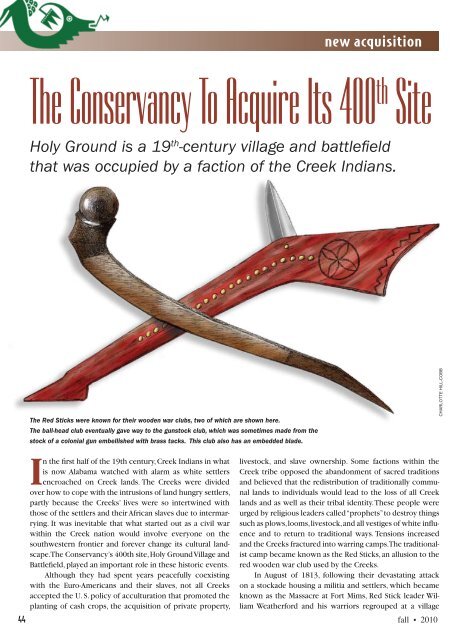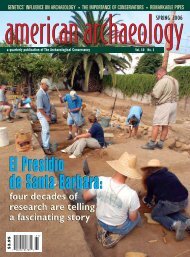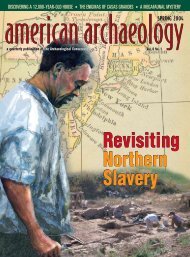Clovis Comet Debate - The Archaeological Conservancy
Clovis Comet Debate - The Archaeological Conservancy
Clovis Comet Debate - The Archaeological Conservancy
Create successful ePaper yourself
Turn your PDF publications into a flip-book with our unique Google optimized e-Paper software.
In the first half of the 19th century, Creek Indians in what<br />
is now Alabama watched with alarm as white settlers<br />
encroached on Creek lands. <strong>The</strong> Creeks were divided<br />
over how to cope with the intrusions of land hungry settlers,<br />
partly because the Creeks’ lives were so intertwined with<br />
those of the settlers and their African slaves due to intermarrying.<br />
It was inevitable that what started out as a civil war<br />
within the Creek nation would involve everyone on the<br />
southwestern frontier and forever change its cultural landscape.<br />
<strong>The</strong> <strong>Conservancy</strong>’s 400th site, Holy Ground Village and<br />
Battlefield, played an important role in these historic events.<br />
Although they had spent years peacefully coexisting<br />
with the Euro-Americans and their slaves, not all Creeks<br />
accepted the U. S. policy of acculturation that promoted the<br />
planting of cash crops, the acquisition of private property,<br />
new acquisition<br />
<strong>The</strong> <strong>Conservancy</strong> To Acquire Its 400 th Site<br />
Holy Ground is a 19 th -century village and battlefield<br />
that was occupied by a faction of the Creek Indians.<br />
<strong>The</strong> Red Sticks were known for their wooden war clubs, two of which are shown here.<br />
<strong>The</strong> ball-head club eventually gave way to the gunstock club, which was sometimes made from the<br />
stock of a colonial gun embellished with brass tacks. This club also has an embedded blade.<br />
livestock, and slave ownership. Some factions within the<br />
Creek tribe opposed the abandonment of sacred traditions<br />
and believed that the redistribution of traditionally communal<br />
lands to individuals would lead to the loss of all Creek<br />
lands and as well as their tribal identity. <strong>The</strong>se people were<br />
urged by religious leaders called “prophets” to destroy things<br />
such as plows, looms, livestock, and all vestiges of white influence<br />
and to return to traditional ways. Tensions increased<br />
and the Creeks fractured into warring camps. <strong>The</strong> traditionalist<br />
camp became known as the Red Sticks, an allusion to the<br />
red wooden war club used by the Creeks.<br />
In August of 1813, following their devastating attack<br />
on a stockade housing a militia and settlers, which became<br />
known as the Massacre at Fort Mims, Red Stick leader William<br />
Weatherford and his warriors regrouped at a village<br />
44 fall • 2010<br />
cHarloTTe Hill-cobb




